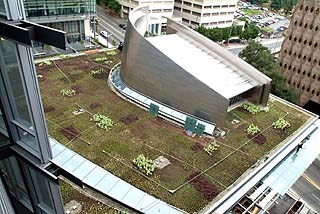
Surveys
DJC.COM
July 29, 2004
Emerald City must fight to stay green
City of Seattle

Nicholas
|
"We are at risk of becoming ‘the city formerly known as Emerald," Mayor Greg Nickels said while launching his ambitious Green Seattle Initiative back in April. "We must take action now to restore our public forests, build healthy neighborhoods and thriving business districts, and keep our city green."
New development consumed about an acre of land every hour during the 1990s in the Pacific Northwest's three largest cities (Seattle, Portland and Vancouver, B.C.), according to a 2001 study by Northwest Environment Watch. The greater Seattle area lost 10 acres to development every day during that period.
Meanwhile, recent analysis by the Seattle Department of Parks & Recreation shows that forest canopy in Seattle is down to a meager 13 percent. And most of what remains is hurting, due to infestations of invasive species such as English ivy, or a severe loss of biological diversity, or both.

Photo courtesy city of Seattle
The new City Hall is only the second large building in Seattle to have a green roof.
|
Enter the Mayor's Green Seattle Initiative, the overarching goal of which is simple: Increase the green in Seattle by protecting, restoring and adding to the lush landscapes that help define and distinguish our city.
The value of green
Much more than our nickname is at stake. The environmental and public health benefits of trees and greenery — producing oxygen, absorbing carbon dioxide and other air pollutants, filtering and storing rainwater — are relatively well known.
Much less well understood and appreciated are the myriad social benefits we get from green, ranging from stress reduction to crime prevention. Extensive research at the University of Illinois, for example, found that areas with maximum greenery had 52 percent fewer crimes and significantly lower levels of domestic violence than those with minimal plant life.
On top of this, there is clear and compelling evidence that a greener city is an economically stronger city. Studies show that trees can increase property values by up to 15 percent, and that patrons of tree-lined business districts spend as much as 10 percent more than those shopping in less-green environs.
In addition, trees and forested areas deliver important services that we would otherwise need to provide by building or expanding expensive public infrastructure systems. For example, American Forests took a hard look at Seattle's urban forest in 1999. It concluded that from 1972 to 1996 we lost 46 percent of our heavy tree cover and 67 percent of our medium tree cover. That dramatic reduction in forest canopy, it estimated, cost us $1.3 million per year in rainwater storage and management capacity and $226,000 per year in air pollution-related health care costs.
The Green Seattle Initiative
The Mayor's Green Seattle Initiative has three main components:
- Significantly accelerate the pace of urban forest restoration work through an innovative Green Seattle Partnership with the Cascade Land Conservancy (see related story on opposite page);
- Provide "green grants" to community groups and neighborhood business districts to help fund re-greening projects in Seattle neighborhoods, with a strong focus on areas most in need of additional trees and greenery; and
- Promote sustainable development practices that mimic and recreate natural systems and increase the green in the built environment.
With so much of our urban landscape consisting of buildings, streets, sidewalks, driveways and parking lots, we can't get to a greener Seattle without a greener built environment — more green buildings, green roofs and green streets.
Though we already have one of the largest clusters of "green buildings" in the country — including the new Central Library downtown and the recently completed Alcyon mixed-use development in South Lake Union — so far only two large buildings, the new Seattle Justice Center and the new City Hall, have green roofs.
The same is true for green streets, which are pedestrian- and bicycle-friendly urban roadways with trees and other greenery on the sides, in the medians, and/or in the spaces between buildings and streets. While a few excellent, on-the-ground examples exist, such as Vine Street, many more are possible — and necessary.
Through the Green Seattle Initiative, the city is actively exploring new ways to promote this kind of green development, including incentives and demonstration projects.
The "greenspace factor" used in European cities such as Denmark and Berlin provides an intriguing model. There, developers are given "green points" for each eco-friendly feature they build into their projects — such as garden plots, green roofs, green walls — and are required to achieve a minimum number of green points at each development site.
The good news
Seattle will never again be an old-growth forest. Nor would we want that. To do our part in meeting the regional commitment to smart growth, we must continue to channel most of the projected increase in people and commerce into our already urbanized places, and away from working forests and farms, and areas that are still rural, open, natural and green.
At the same time, we have to do it right. We have to use new products and approaches to create an urban environment that is healthier not just for the environment, but for people and pocketbooks, too. That, in a nutshell, is green development.
With our large and growing portfolio of green buildings, Seattle already is a leading city in sustainable building and green development. There's no reason we cannot be the leading city. We have the technology; new products and approaches are emerging everyday.
We have the talent, too. A growing cluster of government agencies and local businesses — from city agencies to civil engineering and architectural firms to construction companies — are pioneering the development and use of these new materials and technologies.
And, with large-scale redevelopment under way or on the horizon in places such as Northgate, South Lake Union and the Central Waterfront, we have ample opportunities to put this talent to work.
The dividends will be huge: a healthier, greener, more livable city for our children and ourselves; an even more attractive location for current and future businesses; and a whole new pathway for profit making and job creation, as the need for more cost-effective and environmentally friendly approaches to urban development intensifies in fast-growing cities across the U.S. and around the world, driving up demand for Seattle's green development expertise.
We can't turn back the clock and return to the days when Seattle was mostly rolling hills covered with giant evergreen trees. But we can reaffirm our commitment, and redouble our efforts, to restore and sustain what's left of our urban forest.
We can increase the green in our built environment through sustainable development practices. We can stay true to our trademark and our tagline: the Emerald City.
Steve Nicholas is director of the Seattle Office of Sustainability & Environment. For more information on the Mayor's Green Seattle Initiative, visit www.seattle.gov/environment.
Other Stories:
- Conditional closures — another cleanup remedy
- Guy Battle: design and build to suit your climate
- Washington tests watershed management
- Todd Pacific halts a dirty waterfront legacy
- Going green? Try calling on your contractor
- Seattle prepares to ‘re-green' 2,500 acres
- Washington's new paint law gets the lead out
- Putting a price tag on nature
- South Lake Union: a model for sustainability
- Contractor finds silver at new headquarters
- Government finds gold at Sea-Tac Airport
- Quick Duwamish cleanup begins with teamwork
- 2004: A great year for the local environment
- Getting to compliance with a systems approach
- Don't let your site be taken to the cleaners
- Salmon get a boost from technology
- Low-impact development comes to Pierce County
- Energy Star label now ready for homes
- Improving traffic flow for fish, people
- Troubling times for Hood Canal's waters
- Utilities to study energy coming into homes
Copyright ©2009 Seattle Daily Journal and DJC.COM.
Comments? Questions? Contact us.